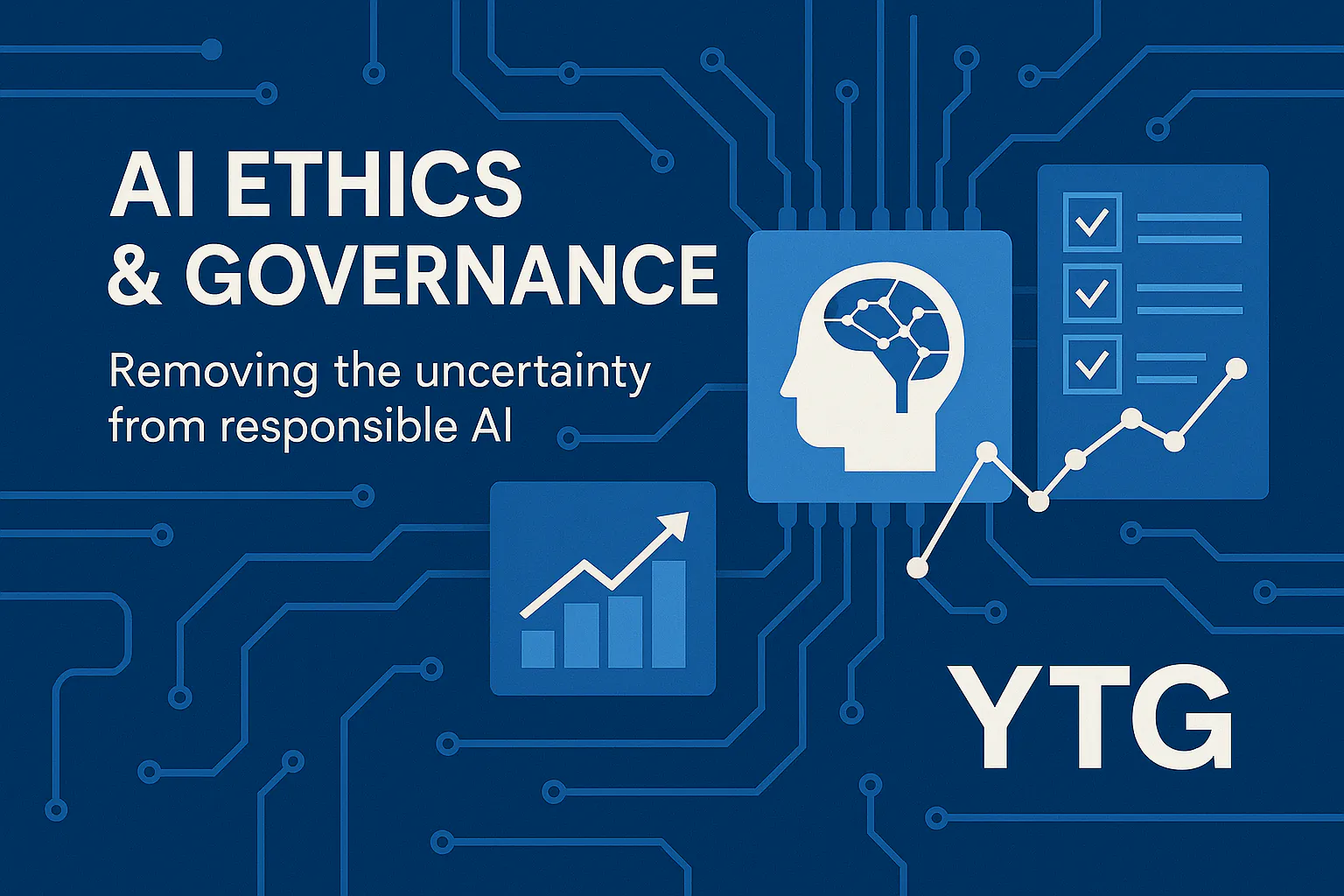AI Ethics and Governance: A Practical Framework for Safer, Smarter Systems
Key Takeaways
- A strong AI ethics and governance framework builds trust, accountability, and compliance into every stage of the AI lifecycle.
- Governance requires clear roles, transparent documentation, and continuous monitoring to prevent bias and manage risk.
- YTG helps organizations design and implement governance systems that make AI safe, auditable, and aligned with business goals.

Looking to use AI with confidence instead of confusion? This guide explains AI ethics and governance in plain language and shows how to stand up a workable model inside your existing processes. You’ll see the roles to assign, the controls to add at each stage of the AI lifecycle, and the documentation to keep. We include a quick-start checklist and a plan you can adapt to your team, with clear points where YTG plugs in.
What Is AI Ethics And Governance?
When we say AI ethics and governance, we’re talking about two tightly-linked ideas:
- AI ethics: the moral and societal principles that guide how AI systems are developed and used (fairness, transparency, accountability, etc.).
- Governance: the policies, roles, controls and oversight mechanisms that ensure those ethical principles are embedded in practice.
Together they mean: “We will build and run AI in a way that aligns with our values, our compliance obligations, and our strategic goals, and we’ll keep oversight on it over time.”
At YTG, our services around AI solutions, cloud migration, and DevOps automation all sit inside a governance umbrella.
Why Ethics And Governance Matter For AI In Business
Here’s the punchline: deploying AI without governance is like launching a ship with no rudder.
- Risk mitigation: AI systems can embed bias, make un-intended decisions, or fail transparency/regulation standards.
- Trust and credibility: Employees, customers and regulators expect responsible use of AI; poor governance undermines trust.
- Business continuity: AI moves fast. Having a governance model helps you adapt to regulation changes, vendor shifts, and operational surprises.
- Strategic alignment: When your AI efforts are tied to business values and oversight frameworks, you avoid building tech in a vacuum that the business can’t maintain.
Core Components Of An AI Governance Framework
Below are the pillars you’ll want to build. These headings form the bones of a strong governance model.
1. Ethical Principles And Policy
Start by defining what “responsible AI” means in your context. For example: fairness (no discrimination), transparency (how the AI decides), accountability (who owns the decision), privacy (data handling), security (resilience), and sustainability (long-term management).
Document the principles in an AI ethics policy that everyone (technical teams, business teams, legal/compliance) can reference.
2. Roles, Responsibilities, And Oversight
Who sits in the driver’s seat when AI decisions are made? You’ll need:
- An executive sponsor or governance committee (sets policy)
- A data/AI steward or model-owner (responsible for the system day-to-day)
- A compliance/legal advisor (ensures regulation alignment)
- An audit/monitoring owner (measures results and alerts issues)
Make sure responsibilities are clear: who approves models, who monitors metrics, who responds if something goes wrong.
3. Process Integration – From Design To Decommission
AI governance must be embedded into the lifecycle of the solution: design → development → deployment → monitoring → retirement.
For each phase:
- Design: apply ethical checklists, bias assessment, privacy impact.
- Development: version control, model documentation, testing for fairness/performance.
- Deployment: change control, logging, performance monitoring, fallback/override mechanisms.
- Monitoring: ongoing metrics (accuracy drift, bias drift, usage logs), alerting.
- Retirement: plan for model de-commissioning, data retention, archiving, or handing off.
YTG’s background in Azure, DevOps and custom software situates us well to build this lifecycle for you.
4. Tools, Data And Infrastructure Controls
Ethics and governance won’t work if your infrastructure can’t support it. Key controls include:
- Data lineage and provenance (trace where training data came from)
- Model interpretability (can you explain decisions?)
- Access controls and identity management (who can change the model/data?)
- Cloud foundation guardrails (cost, deployment, change management) — YTG’s cloud governance services apply here.
- Audit logs and versioning (for traceability).
- Metrics pipeline: accuracy, fairness, drift, misuse metrics.
5. Regulatory And Compliance Alignment
AI touches regulation (depending on region/vertical) such as data privacy laws (GDPR, CCPA), industry specific regulation (finance, health), and emerging AI-specific regulation (e.g., EU’s AI Act draft).
Governance requires mapping your AI use-cases to regulation and applying controls accordingly: risk classification, documentation, human-in-the-loop requirements, transparency disclosures.
Although YTG’s site doesn’t list specific regulatory frameworks, their emphasis on secure, scalable systems and governance suggests they can support clients needing compliance layers.
6. Monitoring, Auditing And Continuous Improvement
AI systems are not “set-and-forget.” They change behavior due to new data, user behavior shifts, upstream ecosystem changes. Governance must include:
- Ongoing monitoring: performance drift, fairness drift, misuse detection.
- Periodic audits: internal or external review of models, data, decisions.
- Governance review loop: revisit policies if issues reported or environment changed.
- Transparent reporting: to stakeholders, to board, to business users.
How To Build A Practical AI Governance Roadmap (Step-by-Step)
Here’s a how-to blueprint you can follow (or adopt with YTG).
Step 1: Conduct an AI Readiness Assessment
Begin with inventory: what AI/ML models do you have or plan? What data do they use? What’s the scope of impact? What regulatory domain are you in?
Then map gaps: Where are roles unclear? What infrastructure lacks controls? What data risks exist?
YTG offers consulting in this space via their cloud readiness and AI solution services.
Step 2: Define Your Ethical Policy & Governance Charter
Draft your policy (see component 1). Then build your charter: governance committee, roles, escalation paths, documentation requirements, metrics to monitor.
Get executive sign-off so the charter has real weight.
Step 3: Establish Infrastructure And Data Controls
Put in controls (see component 4). Set up cloud landing zones (YTG’s expertise). Define identity/access, logging, versioning. Configure metrics pipelines.
Ensure your development process (DevOps/CI-CD) includes governance controls.
Step 4: Embed Governance Throughout The Lifecycle
Update your development process: ethical checklist at design, bias/fairness tests during dev, approval gates at deployment, monitoring dashboards post-deployment, retirement planning.
Train your teams: developers, data-scientists, business users.
Step 5: Launch Monitoring And Audit Programs
Deploy your metrics dashboards. Run periodic audits. Define thresholds for alerts (e.g., fairness metric drop-off).
Set procedure for “model incident” (if decision fairness fails, or drift becomes unacceptable): rollback, human review, retrain.
YTG’s combination of DevOps and analytics services aligns with this need.
Step 6: Review, Document, Communicate
Make your governance visible: regular reporting to stakeholders (board, legal, business owners). Document model provenance, decisions, change logs.
If your business is regulated, keep audit trails ready for compliance.
Make sure your policy evolves as regulation or business context changes.
Common Pitfalls And How To Avoid Them
Understanding what tends to go wrong helps you steer clear.
- Lack of executive buy-in: If the governance charter isn’t backed by leadership, it becomes “nice to have” not “must do”. Remedy: get sponsor, tie to business KPIs.
- Treating governance as a one-time project: Governance needs ongoing work. Remedy: build monitoring, review loop, audit process.
- Ignoring data or model drift: AI evolves after deployment; ignoring it leads to bias or performance decay. Remedy: embed drift monitoring and a plan for retraining or retirement.
- Infrastructure mismatch: If the tooling and controls aren’t in place, governance policies stay theoretical. Remedy: invest in proper stack (cloud landing zones, versioning, logging).
- Siloed roles: If data scientists, legal, business, and IT operate separately, governance fails. Remedy: set cross-functional team, clear responsibilities, training across roles.
How Yocum Technology Group Supports AI Ethics And Governance
YTG brings a unique combination of capabilities that aligns with the governance roadmap above. In specific ways:
- Custom software, AI solutions and automation: YTG builds AI-powered applications and automation workflows.
- Cloud infrastructure & DevOps: YTG offers cloud migration (Microsoft Azure), DevOps automation and landing-zone creation — all essential for governance.
- Data & AI integration: YTG’s services around data modernization and intelligent applications mean they know the data-model lifecycle.
When you engage YTG to set up AI governance, you’ll benefit from:
- Governance design aligned to your business goals and risk profile.
- Infrastructure foundation built for compliance, audit-readiness, monitoring.
- Model lifecycle integration so governance is operational, not just policy.
- Ongoing support for review, audit-reporting, and continuous improvement.
Next Steps For Your Organization
Here’s a quick decision checklist you can run:
- Do you have a documented AI ethics policy?
- Are roles and oversight defined for AI deployments?
- Is your infrastructure (cloud, data, model pipeline) designed with governance in mind?
- Do you monitor your AI models post-deployment (drift, bias, performance)?
- Do you audit and review your model decisions and governance charter on a schedule?
If you answered “no” to any of these, that’s a spot to engage YTG. We’ll help you assess, architect and implement the governance model that aligns with your business, risk profile and technical stack.
Why Yocum Technology Group?
If you're ready to bring structure, accountability and clarity to your AI initiatives, connect with Yocum Technology Group for a governance readiness consultation. Our team will help you map your AI ethics policy, align your infrastructure, and operationalize model oversight—so you can move from prototype to production with confidence.




